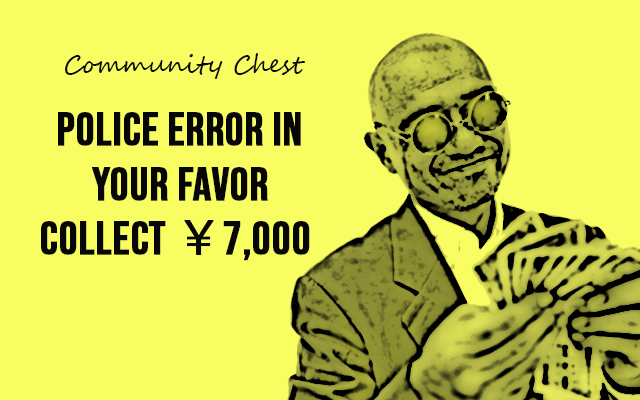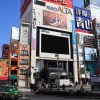
It’s the kind of news you only read about in Monopoly.
Japan can be a tricky place to drive in, and in fact sometimes even the people responsible for issuing and enforcing the rules of the road can sometimes get confused.
For example, let’s take a look at this intersection here in Seto City, Aichi Prefecture.
It’s a bit of a mess. For starters, you have a main city road and a prefectural highway intersecting at a very sharp angle. On top of that the highway becomes one-way on the south side of the intersection, and just to make things extra convoluted there’s a tiny conduit between the highway and the main road, creating an A shape, but that little strip of road is only one-way too.
So let’s say someone is driving towards the intersection from the angle seen below, and they want to turn right onto the highway. They can’t use the small conduit because it’s one-way in the opposite direction, so is it possible to make the very sharp right turn at the main intersection?
Earlier this year, one officer with the Aichi Prefectural Police said “no” and applied for a sign to be installed prohibiting right turns. In August of this year an official sign indicating that traffic could only go left or straight was hung, and for good measure another larger and less formal sign was set up underneath notifying drivers that right turns were not allowed in large print, really driving the point home.
▼ A news report showing the sign
Since then, a total of 168 tickets were handed out to motorists who dared to turn right anyway. It wasn’t until November that another officer with the Traffic Control Division noticed the signs and that they were a mistake.
The general rule is that at intersections between city streets and highways, cars should be allowed to access the highway from a right turn. The particular orientation of this intersection apparently was not a factor, and as a result, the signs were immediately removed.
As for the 168 people who received tickets, the Aichi Prefectural Police officially apologized and promised to both cancel the demerit points and refund all fines, totaling 1.14 million yen (US$10,100).
However, this creates a kind of ethically nebulous situation in which readers of the news were largely divided about who to point the finger at.
“It never occurred to me that some traffic signs might be wrong.”
“So technically didn’t the police violate a traffic rule? We should give them a ticket.”
“What about the people who suffered more from the tickets, like those who got their licenses revoked? How are they compensated?”
“Even if the rule was mistaken, the drivers still knowingly disobeyed the sign though.”
“I wonder if the police officers handing out tickets took a moment to consider if the sign was correct.”
“Those demerit points affect people’s insurance. Does that all go away too?”
“I would be furious if I got a ticket for that.”
“But they did ignore a sign telling them not to turn right.”
Whether this is more a matter of reckless driving or police negligence probably boils down to each individual case, so it would seem the Aichi Police are choosing to settle everything in one fell swoop regardless of the circumstances.
Nevertheless, anyone who’s ever gotten a ticket would agree the last thing you’d expect is to get a full refund and apology for it. That’s about as likely as winning second place in a beauty contest or getting a bank error in your favor.
Source: NHK via Hachima Kiko
Top image: Pakutaso (Edited by SoraNews24)
● Want to hear about SoraNews24’s latest articles as soon as they’re published? Follow us on Facebook and Twitter!

 Over 2,000 Saitama residents to get refunds from the police for “erroneously” issued tickets
Over 2,000 Saitama residents to get refunds from the police for “erroneously” issued tickets Saitama man sues police after getting pulled over for picking his ears while driving, wins about three bucks
Saitama man sues police after getting pulled over for picking his ears while driving, wins about three bucks Should you drive through a red traffic light like this in Japan? Confusing road rule explained
Should you drive through a red traffic light like this in Japan? Confusing road rule explained People wowed by Japanese road signs that change automatically in seconds 【Videos】
People wowed by Japanese road signs that change automatically in seconds 【Videos】 Frightening video shows car speeding through Tokyo’s Scramble Intersection filled with people
Frightening video shows car speeding through Tokyo’s Scramble Intersection filled with people Foreigner’s request for help in Tokyo makes us sad for the state of society
Foreigner’s request for help in Tokyo makes us sad for the state of society Japanese city loses residents’ personal data, which was on paper being transported on a windy day
Japanese city loses residents’ personal data, which was on paper being transported on a windy day Historical figures get manga makeovers from artists of Spy x Family, My Hero Academia and more
Historical figures get manga makeovers from artists of Spy x Family, My Hero Academia and more Harajuku Station’s beautiful old wooden building is set to return, with a new complex around it
Harajuku Station’s beautiful old wooden building is set to return, with a new complex around it Ghibli Park now selling “Grilled Frogs” from food cart in Valley of Witches
Ghibli Park now selling “Grilled Frogs” from food cart in Valley of Witches Celebrate another year of life by putting it in jeopardy with this birthday candle flower
Celebrate another year of life by putting it in jeopardy with this birthday candle flower Naruto art exhibition coming to Tokyo and Osaka with free, new manga for all attendees
Naruto art exhibition coming to Tokyo and Osaka with free, new manga for all attendees One of Tokyo’s most famous meeting-spot landmarks is closing for good
One of Tokyo’s most famous meeting-spot landmarks is closing for good A Gintama fan’s emotional 19-year journey to buy a proper Lake Toya bokuto wooden katana【Pics】
A Gintama fan’s emotional 19-year journey to buy a proper Lake Toya bokuto wooden katana【Pics】 Akihabara pop-up shop sells goods made by Japanese prison inmates
Akihabara pop-up shop sells goods made by Japanese prison inmates McDonald’s new Happy Meals offer up cute and practical Sanrio lifestyle goods
McDonald’s new Happy Meals offer up cute and practical Sanrio lifestyle goods Japanese ramen restaurants under pressure from new yen banknotes
Japanese ramen restaurants under pressure from new yen banknotes French Fries Bread in Tokyo’s Shibuya becomes a hit on social media
French Fries Bread in Tokyo’s Shibuya becomes a hit on social media Studio Ghibli releases new action figures featuring Nausicaä of the Valley of the Wind characters
Studio Ghibli releases new action figures featuring Nausicaä of the Valley of the Wind characters New private rooms on Tokaido Shinkansen change the way we travel from Tokyo to Kyoto
New private rooms on Tokaido Shinkansen change the way we travel from Tokyo to Kyoto Red light district sushi restaurant in Tokyo shows us just how wrong we were about it
Red light district sushi restaurant in Tokyo shows us just how wrong we were about it Tokyo Tsukiji fish market site to be redeveloped with 50,000-seat stadium, hotel, shopping center
Tokyo Tsukiji fish market site to be redeveloped with 50,000-seat stadium, hotel, shopping center All-you-can-drink Starbucks and amazing views part of Tokyo’s new 170 meter-high sky lounge
All-you-can-drink Starbucks and amazing views part of Tokyo’s new 170 meter-high sky lounge Beautiful Ghibli sealing wax kits let you create accessories and elegant letter decorations【Pics】
Beautiful Ghibli sealing wax kits let you create accessories and elegant letter decorations【Pics】 Studio Ghibli releases Kiki’s Delivery Service chocolate cake pouches in Japan
Studio Ghibli releases Kiki’s Delivery Service chocolate cake pouches in Japan New definition of “Japanese whiskey” goes into effect to prevent fakes from fooling overseas buyers
New definition of “Japanese whiskey” goes into effect to prevent fakes from fooling overseas buyers Our Japanese reporter visits Costco in the U.S., finds super American and very Japanese things
Our Japanese reporter visits Costco in the U.S., finds super American and very Japanese things Studio Ghibli unveils Mother’s Day gift set that captures the love in My Neighbour Totoro
Studio Ghibli unveils Mother’s Day gift set that captures the love in My Neighbour Totoro More foreign tourists than ever before in history visited Japan last month
More foreign tourists than ever before in history visited Japan last month New Pokémon cakes let you eat your way through Pikachu and all the Eevee evolutions
New Pokémon cakes let you eat your way through Pikachu and all the Eevee evolutions Sales of Japan’s most convenient train ticket/shopping payment cards suspended indefinitely
Sales of Japan’s most convenient train ticket/shopping payment cards suspended indefinitely Sold-out Studio Ghibli desktop humidifiers are back so Totoro can help you through the dry season
Sold-out Studio Ghibli desktop humidifiers are back so Totoro can help you through the dry season Japanese government to make first change to romanization spelling rules since the 1950s
Japanese government to make first change to romanization spelling rules since the 1950s Ghibli founders Toshio Suzuki and Hayao Miyazaki contribute to Japanese whisky Totoro label design
Ghibli founders Toshio Suzuki and Hayao Miyazaki contribute to Japanese whisky Totoro label design Doraemon found buried at sea as scene from 1993 anime becomes real life【Photos】
Doraemon found buried at sea as scene from 1993 anime becomes real life【Photos】 Tokyo’s most famous Starbucks is closed
Tokyo’s most famous Starbucks is closed One Piece characters’ nationalities revealed, but fans have mixed opinions
One Piece characters’ nationalities revealed, but fans have mixed opinions We asked a Uniqlo employee what four things we should buy and their suggestions didn’t disappoint
We asked a Uniqlo employee what four things we should buy and their suggestions didn’t disappoint Princesses, fruits, and blacksmiths: Study reveals the 30 most unusual family names in Japan
Princesses, fruits, and blacksmiths: Study reveals the 30 most unusual family names in Japan Japan’s National Police Agency plans to introduce fines for bike traffic violations in 2026
Japan’s National Police Agency plans to introduce fines for bike traffic violations in 2026 Japanese youths anger police by sitting at kotatsu table at busy Kyoto intersection【Video】
Japanese youths anger police by sitting at kotatsu table at busy Kyoto intersection【Video】 Tokyo Police Join Forces With Final Fantasy to End Traffic Accidents
Tokyo Police Join Forces With Final Fantasy to End Traffic Accidents Huge torii gate found in the middle of a busy Kumamoto intersection
Huge torii gate found in the middle of a busy Kumamoto intersection AirTag planted on Aichi Prefectural Police car, by someone who doesn’t understand cars well
AirTag planted on Aichi Prefectural Police car, by someone who doesn’t understand cars well Drive recorder catches the moment a car flies into the front of an oncoming bus
Drive recorder catches the moment a car flies into the front of an oncoming bus Japanese survey finds only 23 percent of vehicles stop for pedestrians at crosswalks
Japanese survey finds only 23 percent of vehicles stop for pedestrians at crosswalks Aichi man arrested for pouring coffee milk into station ticket gate
Aichi man arrested for pouring coffee milk into station ticket gate Japanese buzzwords and regional dialects keep Kumamoto drivers safe 【Photos】
Japanese buzzwords and regional dialects keep Kumamoto drivers safe 【Photos】 Japanese YouTuber sleeps on a bed in the middle of Shibuya Scramble Crossing【Video】
Japanese YouTuber sleeps on a bed in the middle of Shibuya Scramble Crossing【Video】 Man rides motorbike into lobby of Fukuoka police station, demands they crack down on rude driving
Man rides motorbike into lobby of Fukuoka police station, demands they crack down on rude driving Japanese city loses residents’ personal data, which was on paper being transported on a windy day
Japanese city loses residents’ personal data, which was on paper being transported on a windy day UPDATE: Situation remains serious at scene of road collapse in Fukuoka
UPDATE: Situation remains serious at scene of road collapse in Fukuoka These “star marks” on the road in Japan that indicate when to use your blinker are amazing【Video】
These “star marks” on the road in Japan that indicate when to use your blinker are amazing【Video】
Leave a Reply